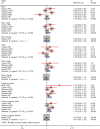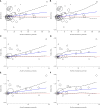Association Between Alcohol Consumption and Risk of Bladder Cancer: A Dose-Response Meta-Analysis of Prospective Cohort Studies
- PMID: 34604033
- PMCID: PMC8479110
- DOI: 10.3389/fonc.2021.696676
Association Between Alcohol Consumption and Risk of Bladder Cancer: A Dose-Response Meta-Analysis of Prospective Cohort Studies
Abstract
Background: Controversial results of the association between alcohol consumption and risk of bladder cancer were reported by the previous meta-analyses.
Objective: To quantitatively investigate the association between alcohol consumption and risk of bladder cancer based on prospective cohort studies, and explore whether there is potential dose-response relation.
Method: PubMed, EMBASE, the Cochrane Library databases, China Biology Medicine disc (CBM), and Chinese National Knowledge Infrastructure (CNKI) were searched for relevant studies. Categorical meta-analysis was performed for risk estimates of any alcohol consumers versus non-drinkers as well as different drinking degrees (light, moderate, and heavy) versus none. And two-stage generalized least-squares regression and restricted cubic spline, as well as fixed-effects dose-response models, were used for linear and nonlinear dose-response relation exploration.
Results: 9 prospective cohort studies including 1,971,396 individuals were finally included. We did not observe a significant association between alcohol intake and the risk of bladder cancer in the entire population. Linear association was detected in those who consumed alcohol from liquor or spirits (P linear=0.02). One drink increment each day of alcohol could elevate the risk of bladder cancer by 9% (RR=1.09; 95%CI: 1.01-1.17). Alcohol was a risk factor of bladder cancer for male drinkers (RR=1.23; 95%CI: 1.13-1.35; I2=3.7%), while none linear or nonlinear relation was found.
Conclusion: No significant association between alcohol consumption and bladder cancer risk was found in the entire population, but there was a linear dose-response relation in those who consume alcohol from liquor or spirits. Alcohol may elevate the risk of bladder cancer in males in a dose-independent way.
Systematic review registration: https://www.crd.york.ac.uk/prospero/, PROSPERO (CRD42020216195).
Keywords: alcohol; bladder cancer; dose-response; meta-analysis; systematic review.
Copyright © 2021 Lao, Li, He, Guan, Li, Wang, Li, Wang, Li, Liu and Dong.
Conflict of interest statement
The authors declare that the research was conducted in the absence of any commercial or financial relationships that could be construed as a potential conflict of interest.
Figures






Similar articles
-
Association between alcohol intake, mild cognitive impairment and progression to dementia: a dose-response meta-analysis.Aging Clin Exp Res. 2021 May;33(5):1175-1185. doi: 10.1007/s40520-020-01605-0. Epub 2020 Jun 1. Aging Clin Exp Res. 2021. PMID: 32488474 Review.
-
Impact of alcohol consumption on the risk of developing bladder cancer: a systematic review and meta-analysis.World J Urol. 2019 Nov;37(11):2313-2324. doi: 10.1007/s00345-019-02825-4. Epub 2019 Jun 6. World J Urol. 2019. PMID: 31172281
-
Does alcohol consumption modify the risk of endometrial cancer? A dose-response meta-analysis of prospective studies.Arch Gynecol Obstet. 2017 Feb;295(2):467-479. doi: 10.1007/s00404-016-4263-y. Epub 2016 Dec 14. Arch Gynecol Obstet. 2017. PMID: 27975130
-
Alcohol consumption and risk of dementia: A dose-response meta-analysis.Medicine (Baltimore). 2019 Jun;98(26):e16099. doi: 10.1097/MD.0000000000016099. Medicine (Baltimore). 2019. PMID: 31261525 Free PMC article.
-
Alcohol Consumption and the Risk of Prostate Cancer: A Dose-Response Meta-Analysis.Nutrients. 2020 Jul 23;12(8):2188. doi: 10.3390/nu12082188. Nutrients. 2020. PMID: 32717903 Free PMC article.
Cited by
-
Contribution of MRE11, RAD50, and NBS1 Genotypes to Bladder Cancer Susceptibility.Cancer Genomics Proteomics. 2025 Jun 26;22(4):575-591. doi: 10.21873/cgp.20523. Cancer Genomics Proteomics. 2025. PMID: 40571318 Free PMC article.
-
Food groups and urologic cancers risk: a systematic review and meta-analysis of prospective studies.Front Nutr. 2023 May 17;10:1154996. doi: 10.3389/fnut.2023.1154996. eCollection 2023. Front Nutr. 2023. PMID: 37266130 Free PMC article. Review.
-
Lifestyle and occupational risks assessment of bladder cancer using machine learning-based prediction models.Cancer Rep (Hoboken). 2023 Sep;6(9):e1860. doi: 10.1002/cnr2.1860. Epub 2023 Jul 5. Cancer Rep (Hoboken). 2023. PMID: 37403801 Free PMC article.
-
Alcohol consumption and its association with cancer, cardiovascular, liver and brain diseases: a systematic review of Mendelian randomization studies.Front Epidemiol. 2024 Nov 7;4:1385064. doi: 10.3389/fepid.2024.1385064. eCollection 2024. Front Epidemiol. 2024. PMID: 39574800 Free PMC article.
-
Wine Consumption and Lung Cancer Risk: A Systematic Review and Meta-Analysis.Nutrients. 2025 Apr 10;17(8):1322. doi: 10.3390/nu17081322. Nutrients. 2025. PMID: 40284187 Free PMC article.
References
Publication types
LinkOut - more resources
Full Text Sources

